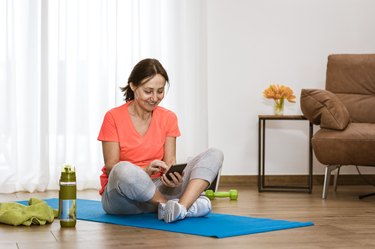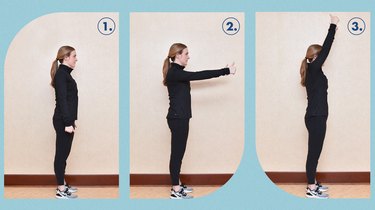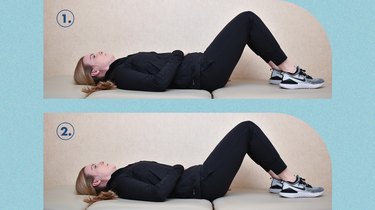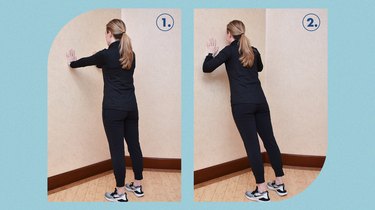

Exercise is a critical component to COVID-19 recovery. After all, infection with the novel coronavirus can have profound effects on physical fitness — no matter the severity of symptoms.
Even in healthy people, just two days of bedrest can lead to muscle loss, neuromuscular damage and decreased aerobic capacity, according to a May 2020 European Journal of Sports Science study. Meanwhile, a June 2020 review in the Journal of Cachexia, Sarcopenia and Muscle found that, all bedrest aside, the novel coronavirus can cause muscle and tissue wasting throughout the body.
Video of the Day
Video of the Day
That's why, in an August 2020 Intensive Care Medicine review, researchers with the Hospital for Special Surgery (HSS) in New York City recommended that recreational exercisers diagnosed with mild or moderate COVID-19 gradually begin exercising five to seven days after their symptoms have passed. Doing so can help fight muscle weakness after COVID-19, encourage better respiratory function, improve mobility and ease the body back into a regular workout routine.
To help get you moving toward a stronger COVID-19 recovery, we asked Sharlynn Tuohy, PT — a physical therapist, senior director of Acute Care Rehabilitation at the HSS and co-author of the HSS Beyond COVID-19 patient rehabilitation exercise program — to share six of the best post-illness exercises you can do at home.
Tuohy recommends starting slow and progressing to 3 sets of 10 to 15 reps of each exercise three times per day. "When you're recovering, it's best to do short amounts of exercise throughout the day as opposed to doing everything all at once," she says. During each exercise, listen to your body and ease up if you feel off. Once the moves become easy to you, add a challenge with the below progressions.
Get tips on how to stay healthy, safe and sane during the novel coronavirus pandemic.
Warning
If you had a serious case of COVID-19 or were hospitalized, don’t attempt these exercises without first consulting your physician or a physical therapist, Tuohy says. These medical experts can help customize a recovery plan that's appropriate for your body's unique needs.
Move 1: Scapular Retraction

- Stand or sit tall and engage your core.
- Without arching your lower back, squeeze your shoulder blades back and together. Feel your upper-back muscles contract.
- Hold the contraction for up to 5 seconds and then slowly relax.
Progress the exercise: Set up with your arms in front of you at shoulder height. Hold the ends of a resistance band in each hand. From here, squeeze your shoulder blades down and together to extend your arms straight out to your sides.
Move 2: Overhead Scaption

- Stand or sit tall with your arms straight down at your sides and your thumbs pointing in front of you.
- Leading with your thumbs and keeping your arms straight, raise your arms overhead to form a narrow Y shape.
- Pause, then slowly lower your arms back to your sides.
Progress the exercise: Do the scaption variation while holding light weights in each hand. Start with 1 or 2 pounds; it will be more challenging than you think!
Move 3: Pelvic Tilt

- Lie face-up on the floor or another firm surface with your knees bent and feet flat on the floor.
- Contract your abs and tilt your pelvis to press your lower back against the floor.
- Hold the position for up to 5 seconds, then relax your abs to reverse the movement.
Progress the exercise: Perform the core exercise with your feet off of the floor, knees above your hips and shins parallel with the floor.
Move 4: Single-Leg Leg Lift

- Lie face-up on the floor or another firm surface. Place one foot on the floor and extend the opposite leg straight out in front of you. Contract your abs to press your lower back into the floor.
- Tighten your extended leg's quadriceps by pushing your kneecap down into the floor.
- Keeping your leg straight, slowly raise it as far as comfortable or until it's in line with your opposite thigh.
- Hold for up to 5 seconds, then lower your leg back to the floor.
- Do all reps, then repeat with the other leg.
Progress the exercise: Try these leg-lift exercise variations, including a double-leg leg lift.
Move 5: Wall Sit

- Stand against a wall with your feet shoulder width apart and about 2 feet away from the wall.
- Extend your arms straight out in front of you and brace your core.
- Slide your torso down the wall, lowering as far as comfortable or until your thighs are parallel with the floor.
- Hold for up to 5 seconds, then drive through your feet to stand up.
Progress the exercise: Secure a mini looped resistance band around your thighs, just above your knees. As you hold the wall sit, don't let the band pull your knees toward each other.
Move 6: Wall Push-Up

- Stand facing a wall. Extend your arms out in front of you and place your palms flat against the wall. Brace your core.
- Keeping your body in a tall plank position, bend your shoulders and elbows to draw your chest toward the wall.
- Pause, then push through your chest and arms to reverse the movement.
Progress the exercise: Perform your push-ups at an incline with your hands on a raised surface such as a kitchen counter or sturdy table. As you're able to without sacrificing form, lower your hands to the floor. Learn proper push-up technique.
Read more stories to help you navigate the novel coronavirus pandemic:
- European Journal of Sports Science: "Impact of sedentarism due to the COVID-19 home confinement on neuromuscular, cardiovascular and metabolic health: Physiological and pathophysiological implications and recommendations for physical and nutritional countermeasures"
- Journal of Cachexia, Sarcopenia and Muscle: "COVID‐19: a major cause of cachexia and sarcopenia?"
- Intensive Care Medicine: "Considerations for Return to Exercise Following Mild-to-Moderate COVID-19 in the Recreational Athlete"
- HSS Journal: "HSS Beyond: Moving Forward After COVID-19"